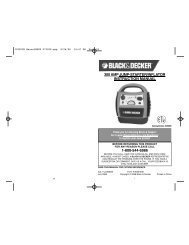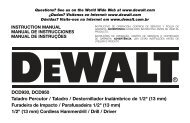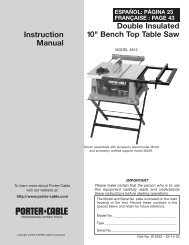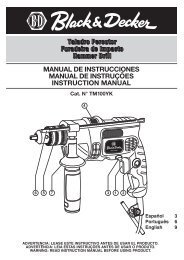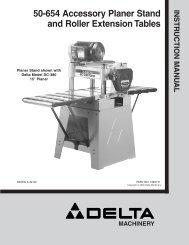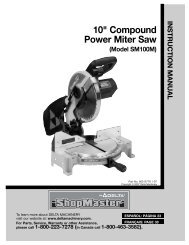90528012 BDMS200 miter saw
90528012 BDMS200 miter saw
90528012 BDMS200 miter saw
You also want an ePaper? Increase the reach of your titles
YUMPU automatically turns print PDFs into web optimized ePapers that Google loves.
NEVER APPLY LUBRICANT TO THE BLADE WHILE THEMACHINE IS RUNNING.CUTTING BOWED MATERIALCheck to see if your workpiece is bowed. If it is, make sure thematerial is positioned on the table as shown in Fig. 34.If the material is positioned the wrong way, as shown in Fig. 35, theworkpiece will pinch the blade near the completion of the cut.WORK SUPPORT EXTENSIONSFor support when cutting long pieces, a work support extension canbe constructed. Fig. 36 illustrates the <strong>miter</strong> <strong>saw</strong> mounted to twostandard 2 x 4’s (A). Fasten the four mounting legs (two of which areshown at (B) Fig. 36 to the 2 x 4’s, using four screws (not supplied)through the four holes in the mounting legs. The length of the 2 x 4’s(A) can vary, depending on the kind of work that will need to be cut.NOTE: Ensure that the top of the support 2 x 4’s (C) are levelwith the <strong>miter</strong> <strong>saw</strong> table.This is critical because the distance from the top of the2 x 4’s (A) to the <strong>miter</strong> <strong>saw</strong> table varies from <strong>saw</strong> to <strong>saw</strong>. In mostcases, standard 2 x 4’s (C) can used. If these are too high, cut the 2 x4s (C) to provide this height or use other properly-sized wood.CUTTING CROWN MOLDINGOne of the many features of the <strong>saw</strong> is the ease of cutting crownmolding. The following is an example of cutting both inside andoutside corners on 52°/38° wall angle crown molding.1. Move the table to the 31.62° right <strong>miter</strong> position and lock the tablein position. NOTE: A positive stop is provided to find this anglequickly.2. Tilt the <strong>saw</strong> blade to the 33.86° left bevel position and tightenbevel lock handle. NOTE: A triangle indicator is provided on thebevel scale to find this angle quickly.3. Place the crown molding on the table with the CEILING EDGE ofthe molding against the fence, and make the cut, as shown in Fig. 37.36NOTE: The piece of crown molding used for the outside cornerwill always be on the right hand side of the blade, as shown at (A)Fig. 37. The piece of crown molding used for the inside cornerwill always be on the left hand side of the blade, as shown at (B)Fig. 37.4. To make the matching halves of the inside and outside corners,rotate the table to the 31.62° left <strong>miter</strong> position.NOTE: A positive stop is provided to find this angle quickly. The<strong>saw</strong> blade is already tilted to the 33.86° left bevel position fromthe previous cut.5. Place the crown molding on the table with the WALL EDGE of thecrown molding against the fence and make the cut. Again, thepiece of crown molding used for the outside corner will always beon the right side of the blade, as shown at (C) Fig. 38. The pieceof crown molding used for the inside corner will always be on theleft side of the blade, as shown at (D) Fig. 38.6. Fig. 39 illustrates the two outside corner pieces; (A) being thepiece cut at (A) Fig. 37 and (C) being the piece cut at (C) Fig. 38.7. Fig. 40 illustrates the two inside corner pieces; (B) being the piececut at (B) Fig. 37, and (D) being the piece cut at (D) Fig. 38.45-45 CROWN MOLDINGNOTE: If you are cutting crown molding that is 45°-45°, follow thesame procedure above, with the exception that the bevel position willalways be at 30° and the <strong>miter</strong> position will be 35-1/4° to the right orleft.OTHER ANGLESNOTE: The above instructions are assuming the angle between thewalls is 90°.




